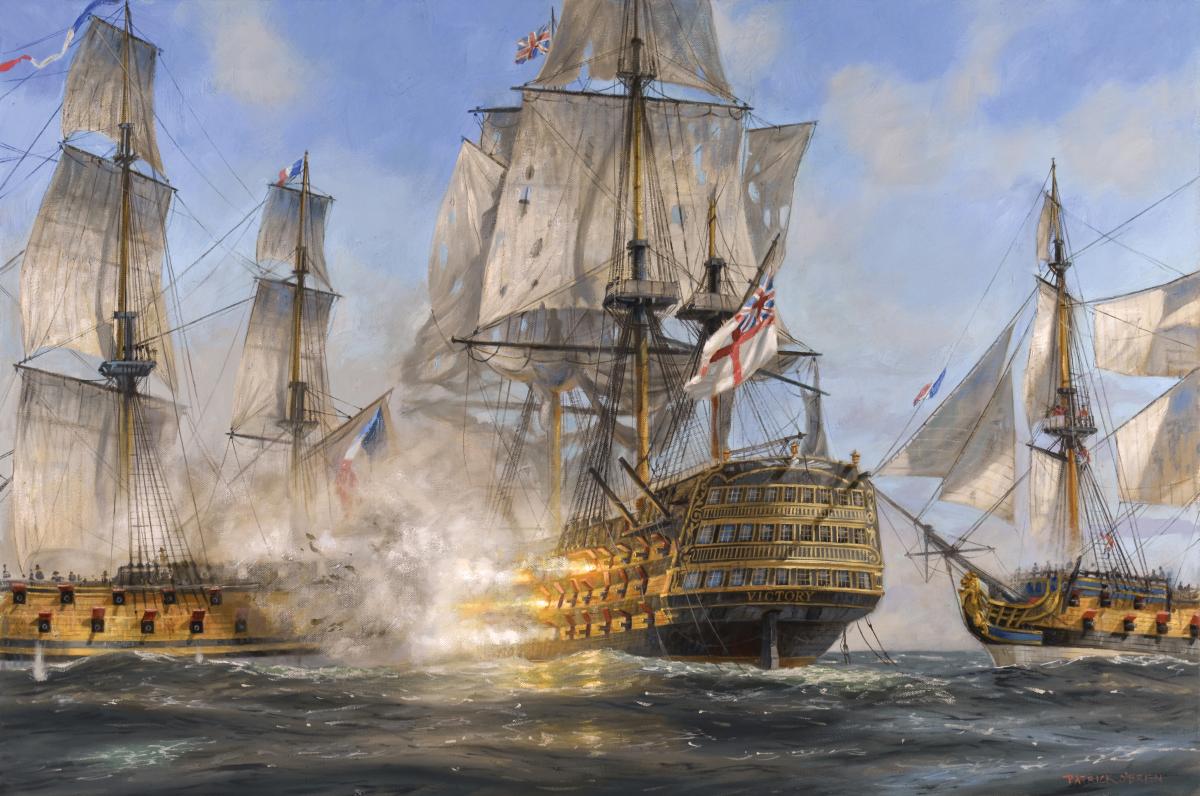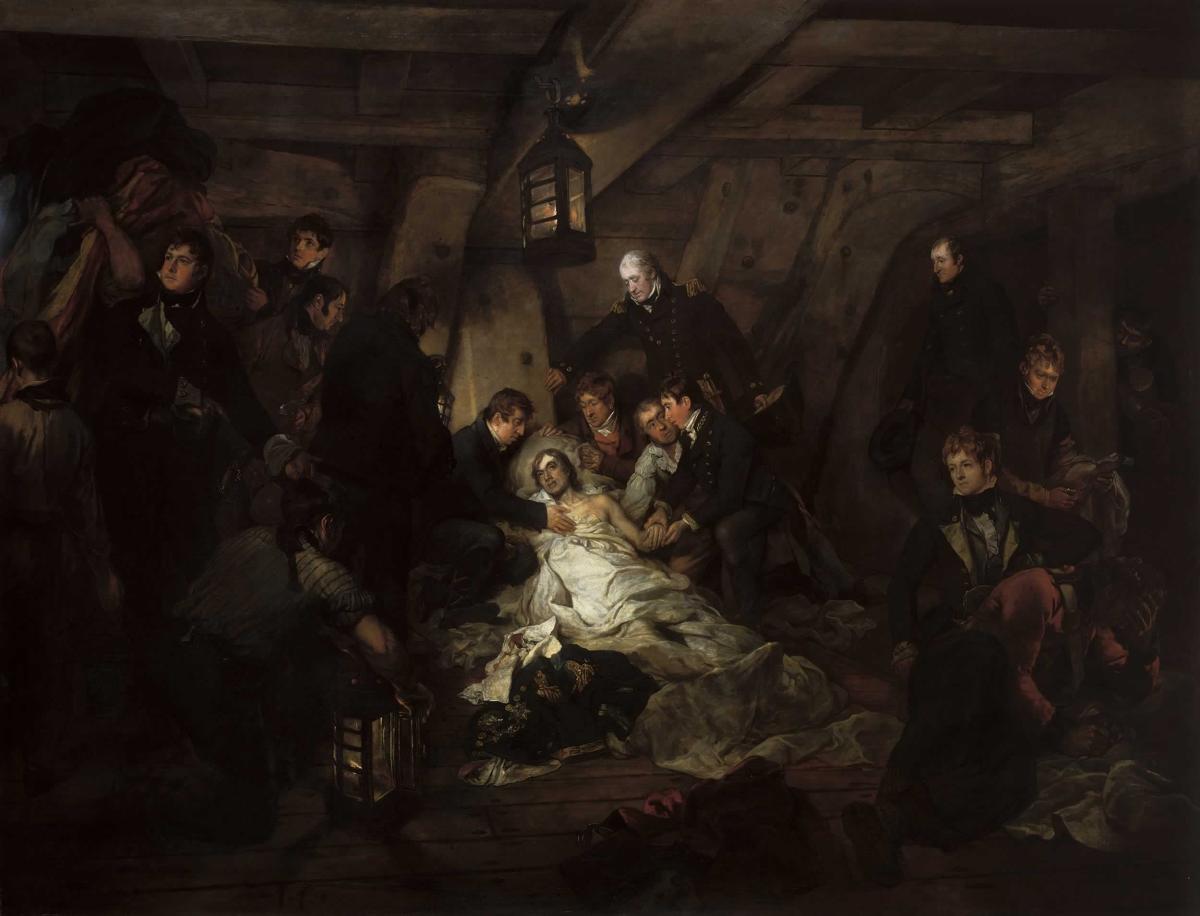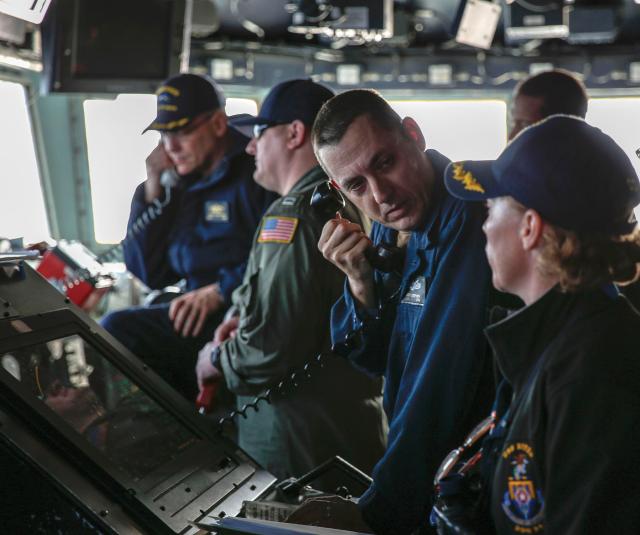On the eve of his greatest victory, Vice Admiral Horatio Nelson told his subordinate commanders, “In case Signals can neither be seen or perfectly understood, no Captain can do very wrong if he places his ship alongside that of the enemy.”1 A fictionalized Nelson also once told Captain Jack Aubrey, “Never mind maneuvers, just go straight at ̓em!”2
Although cited as an example of Nelson’s fighting spirit, the simple advice to close with the enemy was couched within a detailed plan for the upcoming Battle of Trafalgar. Nelson knew his force was better in gunnery and maneuver, with better training and more experience than his French and Spanish enemies, but he did not want his commanders maneuvering for a “perfect” engagement when the tools of victory lay close at hand. The plan could not be an excuse for inaction. Hence, his immortal instructions: close with the enemy and destroy them through superior firepower.
Nelson favored brevity over specificity. He did not tell Captain Aubrey how to “go straight at ̓em.” Teaching sailors how to sail and fight was not his aim, but rather to set his command philosophy, impart it succinctly, and trust his captains to act accordingly.
Modern military thinkers name this approach “mission command.” The gist is that commanders should avoid overly detailed instructions for all eventualities, and instead should favor broad guidance that, in the absence of further instruction, will allow subordinates to achieve the desired goal.
Initiative by Any Other Name
Army thinkers credit 19th-century German military leaders with the invention of mission command.3 The theory developed over the course of that century and came into vogue with the U.S. military following World War II. Also known as commander’s intent or command by negation (the U.S. Navy’s take on the concept), the idea is that commanding officers (COs), or anyone acting without immediate supervision, should be encouraged and empowered to take initiative and act independently in accordance with their higher commander’s guidance.4
Navalists familiar with submarine patrols, single-ship combat, and even fleet actions such as Trafalgar may indulge the Army in its “discovery” of mission command. Maritime history is replete with examples—Trafalgar first among them, as Nelson was mortally wounded during the battle and yet the British emerged victorious. Nelson’s approach, often called “the Nelson touch,” was refined during independent command in the Caribbean; at Copenhagen, where he purposefully disregarded orders; and as a fleet commander at the Battle of the Nile.5
Before radio communications, mission command at sea was the rule. Independent cruisers operated far from supervision. Like Nelson at Copenhagen, commanders had to prioritize accomplishing the mission over orders that were outdated, incorrect, or contrary to combat objectives. In June 1942, more than a century after Trafalgar, U.S. Navy Lieutenant Commander John C. Waldron, commanding officer of Torpedo Squadron Eight, diverted his squadron from the air wing’s course, which he judged to be erroneous; located the Japanese fleet; and, at tremendous cost to his own squadron, bought the time and space needed for a U.S. victory at Midway.6
Barriers to Mission Command
Stories of ship duels and Nelson’s blind eye at Copenhagen seem archaic to the modern officer. Global communications, linked networks, real-time surveillance, and high-bandwidth information transfer promise to trade the fog of war for an endless supply of data. COs at every echelon receive daily updates from their subordinates—on material, personnel, and readiness; equipment, ordnance, supply, and training; and retention, under way periods, and detachment dates. The ones and zeros that fill every officer’s daily life bring with them the promise of perfect decision making; more data, more updates, and more expertise will allow the correct course to emerge from the mists of chaos and present itself to the commander.7
These reports perniciously erode a CO’s independence. Instead of operating their ships, squadrons, or battalions in accordance with their commander’s guidance, COs are training themselves to feed their supervisory command more and more information.
Many a department head has put aside other tasks to build the CO’s weekly update to the destroyer squadron commodore or carrier air wing commander. These commanders in turn update the strike group commander, who updates the fleet commander, ad infinitum, until the President’s desk is clobbered with retention numbers from the USS Ship. Add in administrative commanders (e.g., Naval Air Forces or Surface Force Atlantic), which require their own data, and it can seem as though the fictional Peter Gibbons was speaking for all COs when he declared: “I have eight different bosses.”8
Failure to provide this information results in increasingly shrill emails from the senior command; after all, in the words of famous military thinker Laura Numeroff, “If you give a mouse a cookie, he’ll want a glass of milk.”9 More information begets a need for more information. These updates exist to allow the senior commander to identify things that trouble him, so that he can ask his subordinate commander why this problem, which the senior has identified as problematic, is a problem.
This reliance on steady information creates expectations in both the sender and the receiver. The receiver expects that this information flow will proceed uninterrupted, allowing him to continually refine his decision making until a “correct” choice emerges. The sender, meanwhile, is conditioned to accept autonomy only insofar as it does not impinge on areas where the senior commander has already opined. Field Marshal Helmuth von Moltke, one of mission command’s early proponents, asserted that complex orders or requirements reduce the subordinate’s freedom to act.10
The permissive environments and operations tempo that characterized the past two decades of U.S. Navy operations encourage this “need” for information. Post-9/11, with minor exceptions, deployments have remained predictable, relatively risk free, and characterized by uncontested U.S. dominance of information technology. Even in the midst of combat flight operations, carrier strike group (CSG) warfare commanders provide their admirals with readiness updates and daily operations summaries.
Portions of the fleet routinely do operate with degrees of autonomy. From exercising the right to self-defense while on patrol in the Red Sea, to using missiles to protect troops on the ground, tactical-level decision making in small engagements occurs daily. However, access to information remains uncontested, and consequently, operational combat decisions in the fog of war rarely occur. By and large, the Navy has become so accustomed to information that leaders mistake a high quantity of data for high-quality data.
Trouble arises when reading the tea leaves for future conflict. As the Navy’s focus on distributed lethality implies, future battles likely will require a high degree of autonomy.11 Leaders of squadrons, surface action groups, and their component units will have to make decisions without explicit guidance from above. In such a scenario, the admirals above these “deciders” must be as comfortable with uncertainty as their subordinates are operating without instructions.
A destroyer captain may be unable to report her ship’s position for fear of detection; aircraft may operate beyond friendly radar coverage; any number of factors may preclude reliable communications or updates to higher authorities. Higher level commanders must be prepared for this, and to prepare, they have to get over their information addiction.
Training & Operating with Mission Command
The ancient Greek thinker Archilochus wrote: “We do not rise to the level of our expectations; we fall to the level of our training.”12 This truism brings into question how the Navy “trains” to information availability in the 21st century. The steady drip of updates to an immediate senior in command (ISIC) that is inconvenient today may be impossible in wartime. When the drip dries up, will the Navy be paralyzed without it? If the fleet will fall to the level of its training, it must train to less information and thus cushion its fall.
To wean itself off the idea that more data is better data and that all decisions can be reduced to easy choices with enough information, the Navy must look for ways to reduce the information that currently flows up the chain of command. COs at the O-5 and O-6 levels must look at their information flow and determine what can be trimmed to restore independence to their subordinates.
Remove Requirements
Many commands may find administrative burdens that exist only because they have “always” existed. This is especially true at O-6 level commands, which set requirements for the ships and squadrons below them. It is incumbent on these commands—the destroyer squadron commodores, carrier air wing commanders, submarine squadron commanders, etc.—to identify information they can do without, and then tell their subordinates to stop reporting that information.
One of the Navy’s most insidious aphorisms is: “What is interesting to your boss should fascinate you.” This idea flies in the face of mission command, wherein each commander must be able to prioritize his unit’s needs to meet mission objectives. The ISIC must direct his subordinates, but the ISIC’s focus necessarily differs from his subordinate commanders’ priorities. A commodore who worries about each ship’s medical readiness or depends on an update of each ship’s precise position at sea is setting himself up for failure when the shooting starts and data is outdated before it arrives.
This does not discount the ISIC’s need for actionable information from his COs. Manning, maintenance, and munitions feed combat readiness, and each datum fluctuates in importance over time. In practice, however, there is little “data triage” to separate the wheat from the chaff. Daily commander’s update briefs (CUB) are filled with all available data, good news and bad, relevant or irrelevant.
Frequently, these requirements arise after a one-time request. For example, the USS Ship has a manning problem and brings it to the ISIC’s attention. The ISIC requests further updates, creating a tacit requirement, in force until the ISIC tells the ship’s CO to stop. This order to cease never occurs, and soon enough the ISIC is off to his next duty station, but the requirement remains, briefed until eternity to subsequent commanders. Meanwhile, the other ships in the squadron, seeing the USS Ship’s periodic updates on manning, start sending their own data, despite the fact that they might never have had the same problems that the USS Ship had.
The only option is to stop reporting it. However, if only one CO abruptly stops reporting on personnel, the ISIC likely will ask why, and not politely. Therefore, the ISIC himself must identify which information is required and which is merely desired and kill off the latter.
When ISICs kill requirements, the COs will be able to better communicate their own needs. They will be encouraged to report things that need attention and to operate autonomously otherwise. COs will have to choose wisely what gets brought to the ISIC’s attention, and decide how urgent that appeal is.
To those still clinging to their mammoth PowerPoint slide decks, it may seem this system would be rife for abuse. A CO could use a lack of reporting requirements to hide any number of skeletons. This “pitfall” essentially is an argument that unit COs are dishonest and oriented more toward looking good than effectively commanding their units. But if Navy leaders had so little trust in their COs that they could not trim a few slides from the CUB, how would they ever trust these people in combat?
Color the Admiral White
Beyond the daily administrative changes, the Navy also must train to mission command in combat. In aviation debriefs, to be “colored white” means an aircraft is “killed” and removed from the scenario. This can happen during the mission or afterward in the debrief. To enable mission command, it is time to start coloring ISICs white.
In World War II, five U.S. admirals were killed in action.13 A future major conflict likely will see at least one flag officer casualty; now is the time to learn to fight without one. Capstone predeployment training such as the composite training unit exercise (COMPTUEX) should include periods of time when senior officers are “colored white.” “Casualties” could range from the strike group admiral, to the captain of the “shotgun” cruiser, to the air wing strike lead. For good measure, include other supporting commanders such as those for intelligence and cyber warfare.
In addition, during debriefs, the proctors could color the admiral white, rendering him “dead” for the rest of the conversation. Now the burden of pulling out lessons learned and determining mission success would fall to the next in line, and the admiral gets to attend his own funeral as the ranking O-6 dissects how the event went. This has the ancillary benefit of teaching rising captains to think like admirals.
The organization running the exercise should take the admiral aside, inform him that he has suffered a heart attack or been killed by a falling anvil or by some other means, and confine him to quarters with no phone or email access until the end of the evolution. If the battle problem lasts for multiple days, send the admiral ashore, where he will experience not knowing how things proceed while his subordinates sort things out.
Training exercises need to reflect combat conditions as closely as possible, and combat is chaotic, uncertain, and dynamic. Combat also means indiscriminate death. Ships must prepare to fight through battle damage, dead personnel, and uncertainty, all factors that can be introduced in training to ensure independent action toward victory in combat.
Flag officers in maritime combat are in as much danger as the most junior deck sailor. Admiral Nelson consulted with his captains, gave broad combat guidance, and trusted his subordinates to place their ships alongside the enemy. Consequently, the Royal Navy won Nelson’s greatest victory while the admiral himself bled to death below decks. Twenty-first century commanders must embrace the “Nelson touch” regarding mission command. “Go straight at ̓em,” may seem a simple proposition, but it was nuanced advice to captains who knew what to do when signals could not be seen. How we train to interact with our chain of command, and how we act without them, will be the level to which we fall.
1. “Nelson’s Trafalgar Memorandum,” British Library Board.
2. Peter Weir and John Collee, Master and Commander: The Far Side of the World, directed by Peter Weir (Los Angeles, Twentieth Century Fox, 2003). In truth, this advice was given by Lord Nelson to then-Lieutenant Lord Cochrane and repurposed by Patrick O’Brian for the fictitious “Lucky Jack” Aubrey, who was in part modeled on Cochrane. Edgar Vincent, Nelson: Love & Fame (New Haven, CT: Yale University Press, 2003), 356.
3. COL James D. Sharpe Jr. and LCOL Thomas E. Creviston, USA (Ret.),“Understanding Mission Command,” 10 July 2013.
4. Navy doctrine emphasizes that command by negation, although similar to mission command and commander’s intent, is by nature more independently minded than its land-based counterparts and is indeed not recognized by other services. “U.S. Navy, Maritime Operations at the Operational Level of War: NWP 3-32” (Washington, DC: Office of the Chief of Naval Operations, 2008), 4–12.
5. LCDR Jason Fite, USN, “Study the Past to Win Today,” U.S. Naval Institute Proceedings 144, no. 12 (December 2018).
6. Robert J. Mrazek, A Dawn Like Thunder: The True Story of Torpedo Squadron Eight (New York, NY: 2009).
7. Pauline Shanks Kaurin, “Military Ethics and the Profession, with Pauline Shanks Kaurin,” Midrats podcast, 16 December 2018, 55:10.
8. Mike Judge, Office Space, directed by Mike Judge (Los Angeles: Twentieth Century Fox, 1999).
9. Laura Joffe Numeroff, If You Give a Mouse a Cookie (New York: Harper Row Publishers, 1985).
10. Philip A. Cocker, “Mission Command: Retooling the Leadership Paradigm for Homeland Security Crisis Response?” (master’s thesis, Naval Postgraduate School, 2015), 6.
11. “Surface Force Strategy: Return to Sea Control,” Commander, Naval Surface Forces.
12. Richard Feloni, “Tim Ferriss Lives His Life According to an Ancient Greek Quote that Helps Him Prepare for the Worst,” Business Insider, 1 December 2017.
13. Robert S. Rush, “General and Flag Officers Killed in War,” War on the Rocks, 7 August 2014.





